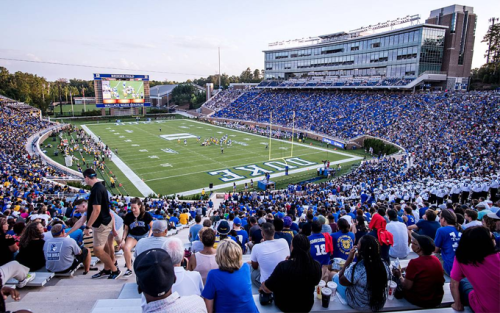
Assessing Duke Athletics Field Irrigation Efficiency
Timeline
2025
Description

Affiliated Course: ENV 790.41 - Sustainable Operations and Supply Chains
Summary: Collaborating closely with facility specialists and field managers of Brooks Field at Wallace Wade Stadium, a team of graduate students researched opportunities to optimize water efficiency on the field and provided stakeholders with insights into understanding the field's water flow. The student team researched best practices for water use on the fields.
Goals:
Because Duke is dedicated to reducing its water impact, the Athletics Department and Facilities Management teams aimed to:
- Catalog irrigation practices on Brooks’ Field,
- Analyze comparable best practices for water conservation at other sporting fields.
- Explore practical opportunities for greater water-use efficiency without compromising field performance.
Experience and Learning Outcomes: The student team assisted in researching what it takes to make the athletics field best-in-class for safety and sustainability by reducing water consumption, reusing water when possible, and limiting the amount of potable water used to irrigate the facility.
The students interviewed managers in charge of turf irrigation to assess both documented and undocumented water maintenance practices and technologies. The team researched sustainable irrigation practices at other stadiums and offered recommendations to minimize water usage and, ideally, reduce related water consumption costs. After conducting a walk-through of the facilities, learning from the facility managers, and visiting the Brooks Stadium, the students determined the practices Duke is using to irrigate its fields as extremely high quality. The students researched rainwater catchment systems as a potential consideration to additionally improve water efficiency. The students researched the movement of water on the field from reservoir to post-irrigation to better understand the sustainability effects of irrigation.
Recommendations: The students demonstrated that Duke facilities already employs many best practices to
irrigate the fields while maintaining high turf quality and safety for athletes. Potential opportunities for improvement include increasing the level of irrigation automation during operation, adding rainwater catchment systems, and implementing a formal data tracking system. The team conducted cost and benefit analysis of these three recommendations, but the feasibility of these recommendations needs to be further analyzed with other key stakeholders in the future. A more immediate action could be the implementation of an automated rain sensor to trigger irrigation based on weather patterns rather than relying on staff to manually adjust watering. The students offered a suggestion for a rain sensor that could be considered in a pilot to save water.
Students: Xizhi Deng, Chenjia Liu, Janice Ye, Cammie Moore
Client: Brandon Hersh, Office of Climate and Sustainability; Cooper Boyce, Landscape Services, Turf Manager; Scott Thompson, Landscape Services, Director
Other stakeholders: Shannon Parker, Executive in Residence at the Nicholas School of the Environment
Academic Projects